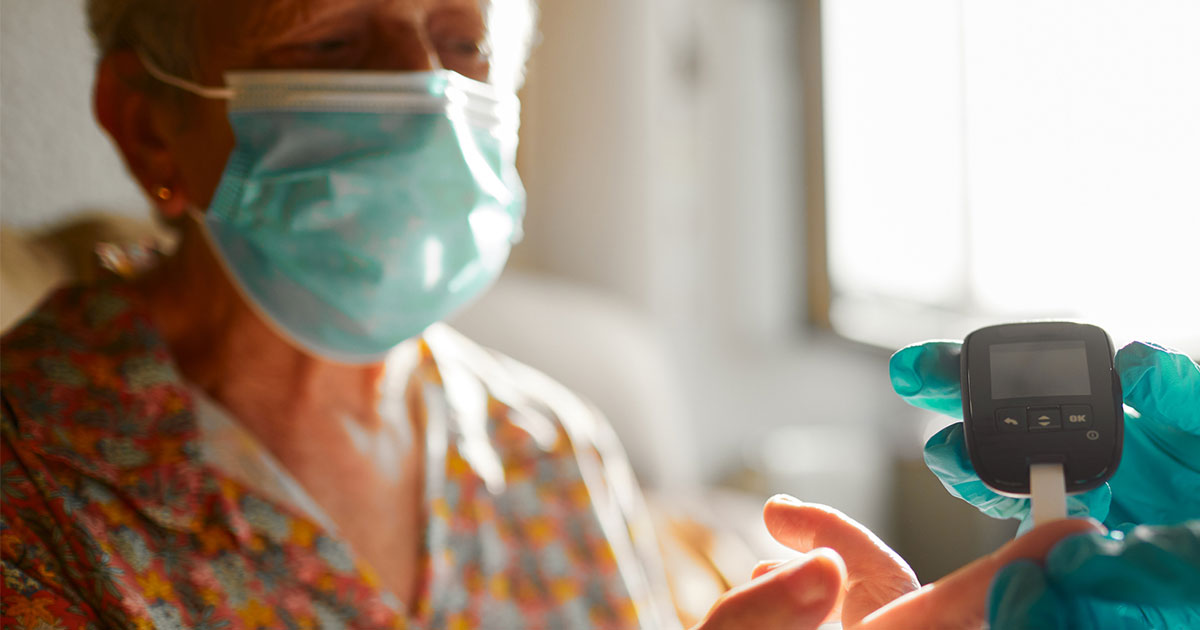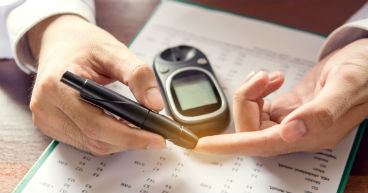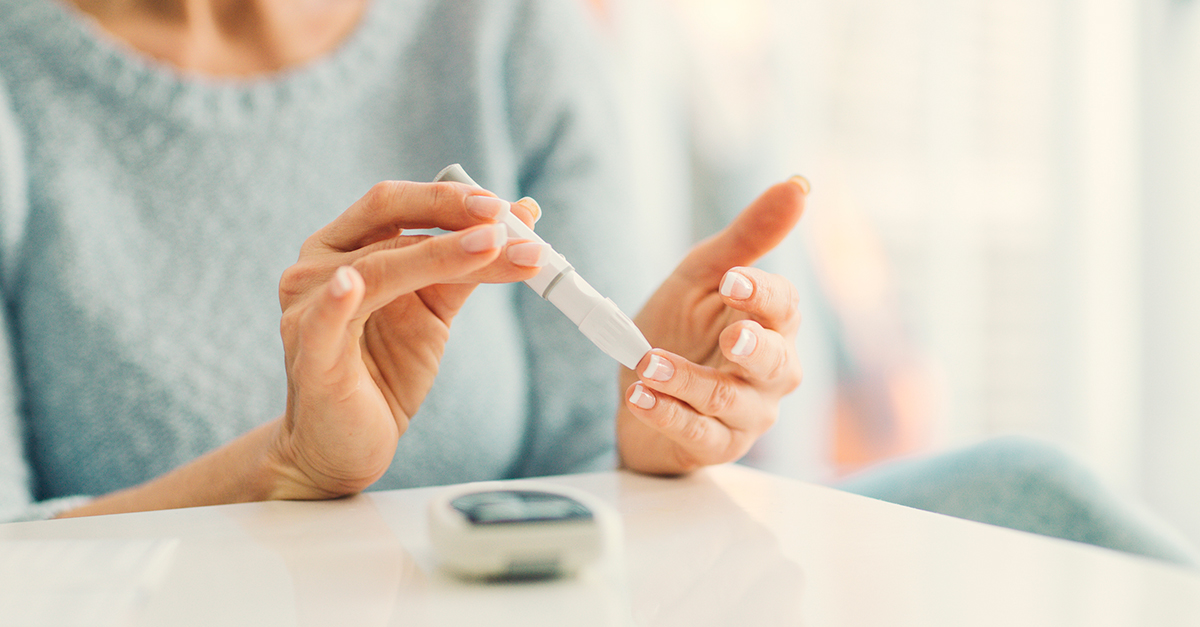
If you put together a profile of people at increased risk of developing cancer, it would look a lot like a description of people at increased risk of diabetes. Connections between the two diseases have been obvious for decades, but only recently have scientists begun identifying a reason for the relationship. What they’re learning is that high glucose levels in the blood, a symptom of diabetes, may contribute to the onset of cancer. Conversely, some cancer-fighting treatments may cause blood sugar spikes—or suppress natural insulin production—and may lead to diabetes.
Diabetes occurs when the pancreas doesn't produce insulin—or enough of it—to convert glucose into energy. The disease may also develop if the body cannot process the insulin being produced.
Many people have both diseases, leading to potential treatment complications for both. For instance, periodic steroid use during cancer treatments may make it difficult to control blood glucose levels. Increased sugar levels may lead to poorer cancer treatment outcomes, delay wound healing and increase risk of infection. High blood sugar, called hyperglycemia, may also exacerbate cancer-related fatigue. Appetite loss caused by some cancer treatments makes it difficult for some diabetics to eat well and maintain healthy blood-sugar levels.
Cancer and diabetes are among the most damaging and most prevalent diseases in the United States. Almost 35 million Americans, roughly 10.5 percent of the population, have diabetes, and another 88 million adults are prediabetic, according to the U.S. Centers for Disease Control and Prevention. Nearly 17 million Americans have a history of cancer, and another 1.8 million new cases are diagnosed annually, the American Cancer Society estimates.
Diabetes has been definitively linked to heart disease, stroke, blindness, kidney damage and an increased likelihood of amputations due to circulatory damage. And now there’s evidence of the link to cancer.
The DNA connection
A 2019 research study at City of Hope, a research and treatment center for cancer and diabetes, looked at deoxyribonucleic acid (DNA) for clues. Cancer develops when mutations to a cell’s DNA cause the cells to grow out of control.
The study found hyperglycemia damages the body’s DNA. The high glucose levels alter the structure of DNA and also suppress its normal repair functions, which may make the genome unstable, creating an opportunity for cancer cells to grow.
Continuing research is being done to see whether available drugs may decrease cancer risk in diabetics. One common medication for diabetes, metformin, has already shown positive results. Metformin helps reduce blood glucose levels and stimulates DNA repair.
Scientists believe that metformin may have some anti-cancer properties through its effect on insulin reduction and also its effect on cell signaling pathways that govern cell growth and division.
A link between cancer and glucose was identified as far back as the 1930s, when German physiologist Otto Warburg—a Nobel laureate—discovered that cancer cells use glucose as fuel, consuming and metabolizing the sugar at a far higher rate than normal cells, according to City of Hope. That knowledge led to advances in the study of cancer. PET (positron emission tomography) scans, which help detect cancer, work by identifying areas of high glucose consumption, for example.
How diabetes may lead to cancer
A July 2018 study confirmed that both type 1 and type 2 diabetes put people at greater risk of developing certain cancers, with the risk higher for women than for men. Researchers reviewed 47 studies worldwide that included health data for almost 20 million individuals.
The researchers from the University of Oxford in Great Britain and Johns Hopkins University in Baltimore reached the following conclusions about cancer and diabetes in men and women:
- Diabetic women have a 27 percent greater chance of developing cancer than healthy women.
- Diabetic men are 19 percent more likely to develop cancer than healthy men.
- Diabetic men have a 12 percent higher risk of liver cancer than diabetic women.
- Compared to diabetic men, diabetic women have a:
- 15 percent higher risk of developing leukemia
- 14 percent higher risk of stomach cancer
- 13 percent higher risk of oral cancer
- 11 percent higher risk of kidney cancer
People with type 2 diabetes, also known as adult-onset diabetes, may have an increased risk of breast, endometrial, pancreatic, liver, kidney and colon cancers.
Here are other factors that may play a role in how cancer develops in diabetes patients:
- The hormone insulin used to control blood sugar levels in diabetes patients also stimulates cell growth, which may increase the risk of cancer.
- The fatty tissue in overweight people produces adipokines at higher levels. These hormones may cause inflammation, another risk factor for cancer.
Cancer treatments raise the risk of diabetes
Just as diabetes increases a person’s risk for developing cancer, cancer may make a person more susceptible to diabetes.
A 2018 study published in JAMA Oncology suggests the incidence of diabetes is six times greater among cancer patients than in people who don’t have cancer. It may not be so much the cancer itself, but the way it’s treated.
In some regions of the body, radiation therapy that attacks cancer cells may also destroy cells that produce insulin. And steroids, which are often used to reduce nausea during chemotherapy, are among the drugs that raise blood sugar levels.
The JAMA Oncology study found the risk for developing diabetes greatest within two years of completing cancer treatments, although the risk remains elevated after that.
Immunotherapies may also contribute to diabetes, according to a May 2020 article in Cure Magazine. Some people who take checkpoint inhibitors commonly used to treat kidney, lung and blood cancers develop severe cases of diabetes. Researchers think the immunotherapies may attack not just cancer cells, but insulin-producing cells in the pancreas as well. The reaction may lead to the more severe type 1 diabetes, an autoimmune disorder. And pancreatic cancer patients are five times more likely to develop type 2 diabetes than similar individuals with no history of cancer.
A similar profile for cancer and diabetes
Many risk factors are the same for cancer and type 2 diabetes, which accounts for more than 90 percent of all diabetes cases, according to the American Diabetes Association (ADA). Those risk factors include:
Age: As you get older, your chances of developing cancer or type 2 diabetes also increase.
Gender: Overall, men are at greater risk for both diseases.
Race/ethnicity: African Americans and non-Hispanic whites are more likely to develop cancer and/or type 2 diabetes.
Weight: Being overweight increases your risk of type 2 diabetes and certain cancers.
Inactivity: Exercise helps lower the risk of type 2 diabetes and some cancers.
Smoking: Smoking is linked to some cancers, and studies suggest it’s also a risk factor for type 2 diabetes.
Alcohol: Women who have more than one drink a day and men who have more than two drinks a day are at higher risk for diabetes and/or cancer.
Obesity may increase the risk of developing not just type 2 diabetes, but 13 different cancers, including:
- Uterine cancer
- Stomach cancer
- Colorectal cancer
- Kidney cancer
Preventive steps you can take
The ADA recommends lowering your risk of getting either diabetes or cancer by:
- Reducing your weight if you’re carrying extra pound.
- Eating healthy—including fresh vegetables, whole grains, fruits, low-fat or non-fat dairy products, lean meats, skinless poultry, fish, seafood and eggs—while watching the size of your portions
- Exercising, staying active
- Stopping use of tobacco products


